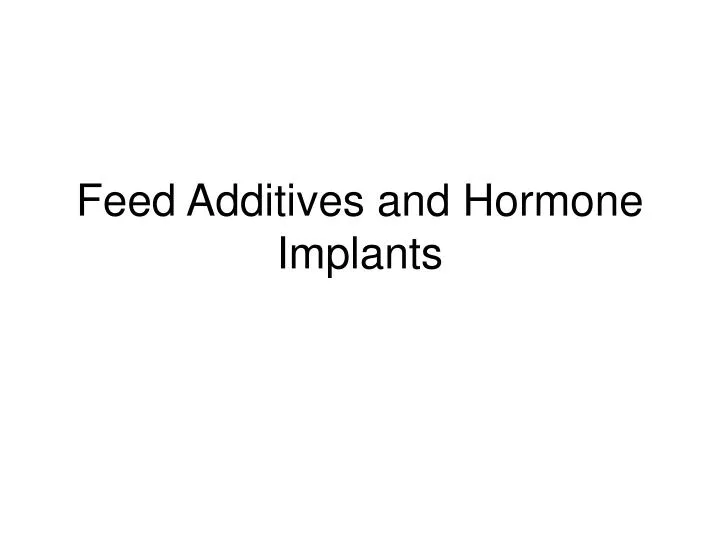Unit 7 Feed Additives and Hormone Implants
![]() Download
Download

Skip this Video
Loading SlideShow in 5 Seconds..
Feed Additives and Hormone Implants PowerPoint Presentation


Feed Additives and Hormone Implants
Download Presentation
Feed Additives and Hormone Implants
- - - - - - - - - - - - - - - - - - - - - - - - - - - E N D - - - - - - - - - - - - - - - - - - - - - - - - - - -
Presentation Transcript
-
Feed Additives and Hormone Implants
-
Feed Additives: Materials used in animal nutrition to -improve feed efficiency -promote faster gains -improve animal health -increase production of animal products
-
Hormone Implants: • Synthetic or natural hormones or hormone-like compounds placed under the skin or in the muscle of the animal • Used to lower production costs by improving both rate and efficiency of gain
-
Performance Stimulants: • Feed Additives and Hormone Implants
-
Antimicrobial Compounds: • Antibiotics and chemotherapeutic compounds • Kill or slow down the growth of some kinds of microorganisms • Livestock and poultry feed additives
-
Subtherapeutic levels of use: • Use of microbial drugs at a lower level in the feed than would be used for treating sick animals • Use in cattle has declined
-
Major difference: • Antibiotics: produced by living things • Chemoantibacterial: compounds made from chemicals • Chemobiotic: antibiotic and an antibacterial combined into one
-
Antibiotics: • Chlortetracycline (Aureomycin) • Neomycin • Oxytetracyline (Terramycin • Penicillin • Streptomycin • Tylosin
-
Ionophores • Used in ruminants • Monensin (Rumensin) • Bovatec • Both common in cattle
-
Chemoantibacterial compounds: • Carbadex • Furazolidone • Nitrofurazone • Sulfmethazine
-
Nutrient-sparing: • The substance allows animals to use available nutrients more effectively • Stimulate microbes in the digestive tract to produce more nutrients • Some thin the intestinal wall to allow easier absorption of nutrients • Daily intake of feed increase • Conversion to meat faster • Control subclinical diseases
-
Broad-spectrum antibiotics: • Control many different microorganisms • Preferred as feed additives • Better results in rate of gain, feed efficiency, and improved animal health
-
Narrow-spectrum: • Control only a few microorganisms • Used to control a specific disease problem that my be present in the group of animals being fed
-
Hormones: • Secreted by: adrenal cortex, pancreas, pituitary, ovaries, and testis • Regulate: body functions, metabolism, reproduction • Used primarily in beef nutrition • Use is very controversial
-
Anthelmintics: Dewormers • Used to control various species of wormer Examples: hygromycin, loxon, phenothiazine, piperzine, thiabendazole, tramisol Common worms that infest species: roundworms, nodular worms, whip worms
-
Other additives: Coccidiostats: added to poultry rations to prevent coccidiosis Sodium bicarbonate and ground limestone: used to regulate pH in ruminant stomach Thyropotein: added to regulate metabolism and the functions of the thyroid
-
Poloxalene (Bloat Guard): prevents bloat in ruminants • Hydroxyzine, reserpine, trifluomeprazine: tranquilizers added to reduce stress on feedlot animals • Copper compounds: added to improve performance of swine
-
Probiotics: change the bacterial population of the digestive tract • Propionic acid: used to slow development of molds in feed
-
Beef cattle use: • Major users of additives and hormones • Increases feed efficiency and rate of gain • Antibiotics fight microorganisms that cause foot rot, liver abscess, respiratory disease, and shipping fever • High percent of rations use: Rumensin or Bovatec (both ionophore antibiotics)
-
Hormone implants: • Improve rate of gain and feed efficiency • Place all implants in middle 1/3 of ear • Can't be used with breeding stock
-
Sheep and goat use: • Not a common practice • Broad-spectrum antibiotics used in feeder lamb rations • Ammonium chloride used in goat rations to reduce urinary calculi
-
Regulation of additives: • FDA regulates • Current rules found in Feed Additive Compendium
-
Feed label requirements: • Any levels of any drugs must be labeled medicated • "medicated" must appear under the feed name • Name and amounts must be listed on tag • Withdrawal must be printed • Caution and directions must be given
-
Improper Mixing: • Can cause some animals to get too much and other too little • Causes drug residue in livestock – be condemned at slaughter • Use vertical and horizontal mixers • Clean mixer after each batch
-
Health concerns: • Continued use may result in a resistant strain of microorganisms • FDA is concerned about possible carcinogenic effects of feed additives
-
If we stop using these: • Raise the cost of animals to the consumer • Less meat and livestock production • Higher production costs • More feed required • Increase in death loss • Increase vet bills
Source: https://www.slideserve.com/goldy/feed-additives-and-hormone-implants
0 Response to "Unit 7 Feed Additives and Hormone Implants"
Post a Comment